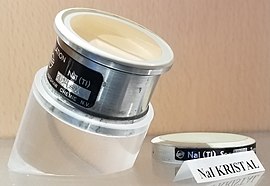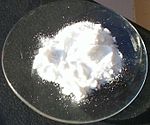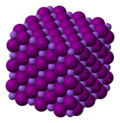Sodium iodide
| |||
 NaI(Tl) scintillators
| |||
| Identifiers | |||
|---|---|---|---|
| |||
3D model (
JSmol ) |
|||
| ChEBI | |||
| ChEMBL | |||
| ChemSpider | |||
ECHA InfoCard
|
100.028.800 | ||
PubChem CID
|
|||
RTECS number
|
| ||
| UNII | |||
CompTox Dashboard (EPA)
|
|||
| |||
| |||
| Properties | |||
| NaI | |||
| Molar mass | 149.894[1] | ||
| Appearance | white solid deliquescent[1]
| ||
| Odor | odorless | ||
| Density | 3.67 g cm−3[1] | ||
| Melting point | 661 °C (1,222 °F; 934 K)[1] | ||
| Boiling point | 1,304 °C (2,379 °F; 1,577 K)[1] | ||
| 1587 g/L (0 °C) 1842 g/L (25 °C) 2278 g/L (50 °C) 2940 g/L (70 °C) 3020 g/L (100 °C)[2][3] | |||
| Solubility | ethanol, acetone[1] | ||
| Band gap | 5.89 eV[4][5] | ||
| −57×10−6 cm3 mol−1[6] | |||
Refractive index (nD)
|
1.93 (300 nm) 1.774 (589 nm) 1.71 (10 μm)[7] | ||
| Structure[8] | |||
| Halite, cF8 | |||
| Fm3m, No. 225 | |||
a = 0.6462 nm
| |||
Formula units (Z)
|
4 | ||
| Octahedral | |||
| Thermochemistry[9] | |||
Heat capacity (C)
|
52.1 J mol−1 K−1 | ||
Std molar
entropy (S⦵298) |
98.5 J mol−1 K−1 | ||
Std enthalpy of (ΔfH⦵298)formation |
−287.8 kJ mol−1 | ||
Gibbs free energy (ΔfG⦵)
|
−286.1 kJ mol−1 | ||
| Hazards | |||
| Occupational safety and health (OHS/OSH): | |||
Main hazards
|
Irritant, can harm the unborn child | ||
| GHS labelling: | |||
 
| |||
| Danger | |||
| H315, H319, H400 | |||
| P273, P305+P351+P338[10] | |||
| NFPA 704 (fire diamond) | |||
| Flash point | Non-flammable | ||
| Safety data sheet (SDS) | [1] | ||
| Related compounds | |||
Other anions
|
Sodium fluoride Sodium chloride Sodium bromide Sodium astatide | ||
Other cations
|
Francium iodide
| ||
Except where otherwise noted, data are given for materials in their standard state (at 25 °C [77 °F], 100 kPa).
| |||
Sodium iodide (
Uses
Food supplement
Sodium iodide, as well as
Organic synthesis

Sodium iodide is used for conversion of
- R–Cl + NaI → R–I + NaCl
Nuclear medicine
Some radioactive iodide salts of sodium, including Na125I and Na131I, have radiopharmaceutical uses for thyroid cancer and hyperthyroidism or as radioactive tracer in imaging (see Isotopes of iodine > Radioiodines I-123, I-124, I-125, and I-131 in medicine and biology).
Thallium-doped NaI(Tl) scintillators
Sodium iodide
Radiocontrast
Solubility data
Sodium iodide exhibits high solubility in some organic solvents, unlike sodium chloride or even bromide:
| Solvent | Solubility of NaI (g NaI/kg of solvent at 25 °C)[17] |
|---|---|
H2O |
1842 |
| Liquid ammonia | 1620 |
| Liquid sulfur dioxide | 150 |
| Methanol | 625–830 |
| Formic acid | 618 |
| Acetonitrile | 249 |
| Acetone | 504 |
| Formamide | 570–850 |
| Acetamide | 323 (41.5 °C) |
| Dimethylformamide | 37–64 |
| Dichloromethane | 0.09[18] |
Stability
Iodides (including sodium iodide) are detectably oxidized by atmospheric oxygen (O2) to molecular iodine (I2). I2 and I− complex to form the triiodide complex, which has a yellow color, unlike the white color of sodium iodide. Water accelerates the oxidation process, and iodide can also produce I2 by photooxidation, therefore for maximum stability sodium iodide should be stored under dark, low temperature, low humidity conditions.
See also
References
- ^ a b c d e f Haynes, p. 4.86
- D. Van Nostrand Company. p. 655.
- ^ Haynes, p. 5.171
- .
- .
- ^ Haynes, p. 4.130
- ^ Haynes, p. 10.250
- .
- ^ Haynes, p. 5.36
- ^ "Sodium iodide 383112". Sigma Aldrich.
- ^ ISBN 978-3527306732.
- PMID 26228378.
- .
- .
- ^ "Scintillation Materials and Assemblies" (PDF). Saint-Gobain Crystals. 2016. Archived from the original (PDF) on October 31, 2017. Retrieved June 21, 2017.
- ^ PMID 4877763.
- ISBN 9780470262931.
- .
Cited sources
- Haynes, William M., ed. (2016). ISBN 9781498754293.
External links
- "ICSC 1009 – Sodium Iodide (Anhydrous)". International Chemical Safety Card. April 20, 2005. Retrieved June 21, 2017.
- "Material Safety Data Sheet (MSDS) – Safety data for sodium iodide". ScienceLab.com. May 21, 2013. Archived from the original on June 3, 2018. Retrieved June 21, 2017.
- "Sodium iodide (Oral route, Injection route, Intravenous route)". Drugs.com. 2017. Retrieved June 21, 2017.
- "Safety Data Sheet – Sodium iodide" (PDF). Global Safety Management. January 23, 2015. Retrieved October 16, 2019.



